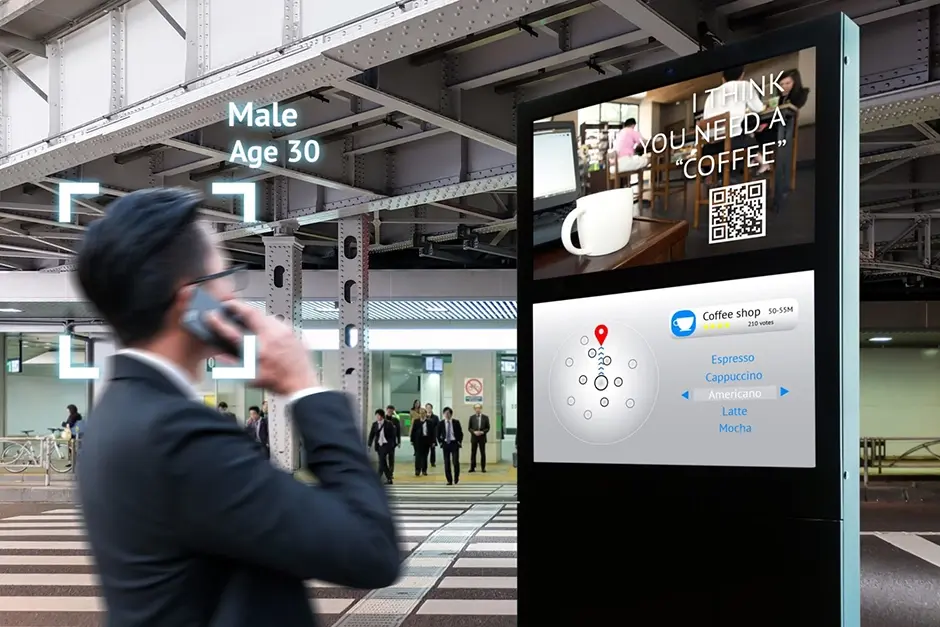Why are Digital Signage Screens
so Effective?
Introduction
Digital screen signage has quickly become an important communication tool for companies everywhere. Many studies have shown that it is highly effective. For example, a 2010 study revealed that 70% of Americans saw a digital screen in the past month, and 52% viewed one within the past week. These numbers have likely increased significantly since then.
Nowadays, digital signage users can using Navori, measure audience footfall or vehicle counting for outdoor applications, and obtain metrics by hour, day of the week, or compare periods.
Furthermore, more people notice digital signage displays, spend more time engaging with them, and remember the information better.
Deployed with professional-grade software that meets your ambitions, digital signage is proving to be more effective than traditional printed posters and in-store materials for the following reasons:
Digital signage content is dynamic
The dynamic nature of digital signage content ensures that it constantly evolves and adapts to provide engaging and up-to-date information. Unlike traditional static signage, businesses can easily update digital displays in real-time with fresh content. This active approach allows them to stay relevant by showcasing current promotions, news, and events.
Whether it’s displaying the latest product offerings, sharing real-time social media feeds, or providing interactive elements, digital signage content actively captivates and informs audiences. The ability to quickly modify and customize content ensures that viewers always receive timely and engaging information, making digital signage software a powerful and versatile communication tool in today’s fast-paced world.

Digital screen signage increases sales
Studies after studies have proven that digital signage displays sell more products compared to other forms of point of purchase signs. Dynamic digital displays are the “silent salespeople” of the 21st century. A digital screen is always available. And it’s ready to help shoppers by providing product features and benefits, pricing, and more.
TV ads can be re-purposed and shown on digital signage displays. It can be mixed in with product information, items on sale, and other content of interest to shoppers. Digital signage has found its way into automobile dealerships, food stores, furniture and appliance stores, home décor and renovation stores, warehouse stores, and other retail locations.

Digital signage helps to communicate better
Installing displays in offices, lunch rooms, and common areas has demonstrated significantly higher effectiveness compared to the traditional “bulletin board” approach. These displays allow constant updates of the content, offering a continuous flow of information, entertainment, and educational clips. Call centers can connect displays to automated information systems, showcasing valuable statistics such as call response times.
Digital signage has greatly improved business intelligence as well. Real-time critical business data and statistics are displayed on screens facing employees. These systems ensure that staff receives up-to-date information, enabling prompt and efficient decision-making.

Digital screen signage delivers content instantly
Being able to quickly send messages and activate media content on extensive networks of connected displays is vital for various purposes.
For instance, the education and government sectors rely on instant messaging and alert functions.
Retail store and quick service restaurant operators find it beneficial to showcase current pricing information on their point of sale signs and digital menu boards.
Office managers and corporate communication officers need to keep employees and visitors informed.
The list of applications can continue indefinitely. We could go on, and on…
Digital signage leads the way
Advances in digital signage technologies have clearly helped the wayfinding sector of digital signage. They have transformed what used to rely on static signage boards into fully interactive visitor information systems. Designers now have the ability to deliver a complete interactive multimedia experience by connecting digital signage hardware players to touch screens.
Typically, the touchscreen displays a 2D or 3D layout. Visitors can easily navigate the plan by directly pointing to their desired destination. The screen then displays a path to guide them. In some cases, a video tour highlights the path, providing visual guidance to the destination. Additionally, wayfinding kiosks can offer further information through QR codes that visitors scan using their smartphones or through the use of SMS and similar technologies.

Digital signage is a revenue generator
Digital signage advertising networks experience high profitability and growth. Advertisers carefully position flat panel displays to achieve maximum visibility, guaranteeing the highest possible viewership. This viewership is crucial for brand owners and advertisers. Digital signage displays often integrate viewership measurement technologies, providing accurate viewership profiles.
Marketers and advertising agencies can associate ad impressions with specific demographics, enabling the creation of highly targeted ad campaigns that outperform other platforms. Digital signage has the capability to deliver tailored content based on screen location or demographic, making it an indispensable tool for modern advertising programs.
DOOH programmatic generates revenues through the sale of advertising space in digital out-of-home (DOOH) networks using automated real-time bidding platforms. Advertisers bid on available inventory based on audience demographics, location, and other targeting criteria, allowing for more precise ad placements.
DOOH programmatic drives revenue growth by maximizing the monetization of digital signage assets while providing advertisers with efficient and effective means to reach their target audiences.
Digital signage motivates
Corporate management actively supports employees in remote locations by recognizing the significance of effective internal communications. Salespeople and truck drivers, who frequently travel, may experience a sense of isolation from the main office, leading to them missing out on important company messages and feeling excluded. This situation can result in decreased morale and a feeling of disconnection.
To tackle these challenges, digital signage provides a solution. It efficiently broadcasts information over any distance at a minimal cost, with the flexibility to use as many screens as needed. These screens continuously refresh with new information, ensuring that employees stay well-informed. Managers and human resources personnel proactively share engaging and up-to-date content to keep the entire staff informed. Furthermore, updates can be delivered at any time, reaching all employees regardless of their location.
Digital signage informs and educates
Successful companies plan their digital signage projects in such a way as to maximize staff and customer exposure. This way, content can be tailored for each audience. Customers are presented with sales, advertising, or informational content while the staff is provided with training content, sales information, and many other business focused information streams. The idea is to increase the return on investment by leveraging the entire digital signage network.

Digital signage entertains
One of the most useful applications of digital signage technologies revolves around entertaining viewers. Nowhere is this more important than where there are long wait times. For example inside elevators, in elevator hallways, in waiting rooms, at store checkouts, in government offices, and other similar locations.
Digital signage displays located in these areas can provide much needed entertainment content which helps reduce perceived dwell times. This is essential to improve customer and visitor experience, for any type of venue. In these cases, it’s best to provide a mix of advertising, infotainment, and news to get optimal results.
Digital screen signage makes a bold impression
Architects and interior decorators can use innovative environmental signage concepts to make digital signage displays a part of the décor. By breaking free from the usual horizontal and vertical orientations, they can create stunning building facades and inviting lobbies.
Using video walls and dynamic video animations, decorators can easily change the look of any open space or adjust the mood based on the time of day, special events, or other criteria. LED displays and flat panels can be arranged in different ways to create a strong visual impact. Moreover, the content can be made up of repurposed animations or videos, allowing for creative flexibility.
Recommended Hardware:
For a seamless and powerful digital signage experience with Navori software, we recommend the Navori Stix 3700 hardware device. The Navori Stix 3700 is a compact yet robust media player designed to deliver high-quality content playback and management. With its efficient Intel processor and ample storage capacity, the Stix 3700 ensures smooth operation and reliable performance for your digital signage network.
Equipped with advanced connectivity options including HDMI, USB, and Ethernet ports, the Stix 3700 seamlessly integrates with various display setups and network configurations. Its small form factor allows for easy installation behind displays or in tight spaces, making it suitable for a wide range of deployment scenarios.
With support for 4K Ultra HD resolution and hardware-accelerated video decoding, the Navori Stix 3700 delivers crisp and vibrant visuals, enhancing the impact of your digital signage content. Whether you’re displaying dynamic advertisements, interactive presentations, or real-time information updates, the Stix 3700 ensures that your content is showcased with precision and clarity.
With its reliable performance, versatile connectivity, and compact design, the Navori Stix 3700 is the ideal hardware solution for powering your digital signage network with Navori software. Experience the power and efficiency of Navori digital signage with the Navori Stix 3700 media player.

 Copy link
Copy link